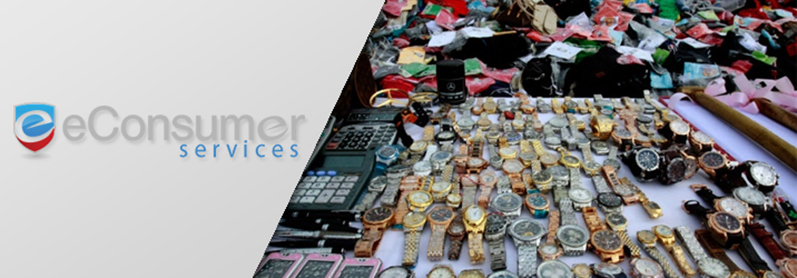How to Avoid Counterfeit Merchandise
Tips to Help Consumers Avoid Counterfeits
Everyone loves a good deal, and there is nothing wrong with shopping around to find low prices for high-end goods. But when a deal comes along that seems too good to be true, it probably is.
Buying counterfeit products leaves you with bogus merchandise, can render your personal information vulnerable to identity theft, and funds crime rings and other illegal operations.
Learning how to avoid counterfeits is one of the best ways to get the goods that you want without risking identity theft. Read on to learn more about this surprising industry and how to protect yourself and your wallet from fakes.
Counterfeit Merchandise: A Booming Business
While you might expect counterfeits to be confined to the back alleys of foreign countries, the reality is that counterfeit products are more prevalent worldwide than is commonly thought. In fact, about 5% of all goods traded in the world are fakes.
Selling fake goods has always been a part of commerce, but it has grown exponentially in recent years. The counterfeit merchandise industry has grown a jaw-dropping 10,000% in the last two decades, fueled in part by growing consumer demand for luxury goods. The ease of which counterfeit products can be sold on the internet has also contributed to this growth.
Counterfeit merchandise can be anything from the expected (such as purses and sunglasses) to the puzzling (such as condoms and car parts).
This means that shoppers, especially online shoppers, must be vigilant when making purchases to ensure that the goods they buy actually are what they say they are.
Listed below are 7 steps that you can take to avoid counterfeits and protect your identity.
1. Shop with reputable businesses.
Shopping with reputable businesses is especially important if you plan on purchasing a big-ticket item from an off-brand business. Doing a little research about the business before you buy can save you from a lot of headaches and unscrupulous dealings.
It is fairly easy to check a business’s reputation by doing the following:
- Check to see if the business is a member of its industry’s professional association. Businesses that peddle counterfeit goods are unlikely to gain membership.
- Research the business online by typing the business’s name followed by “reviews” in any search engine. If only complaints appear then steer clear.
- Refer to the Better Business Bureau website to determine if the business is legitimate and whether other customers are satisfied with their shopping experience.
2. Know the red flags in counterfeit ads.
Common red flags of counterfeit merchandise include overuse of words such as “authentic,” “real,” and “genuine.” Ads that overuse these words are most likely attempting to convey non-existent legitimacy.
Similarly, some product descriptions may use qualifiers such as “inspired by” to sneakily pass off fake goods as the real thing. Don’t be fooled by cunning catch phrases.
3. Only pay if the transaction is secure.
It is easy to tell if an online transaction is secure: the website will begin with https:// and there should be a lock symbol somewhere in the browser. The “s” in the address stands for secure, and the lock indicates that the site is safe.
Avoid putting personal information into non-secure computers, such as those at a public library or while connected to non-secure Wi-Fi in public places, even if the site does have the “s” in the URL.
4. Get quality assurance when purchasing second-hand goods.
Sometimes buying goods second-hand can offer incredible deals, but it also makes counterfeit products more difficult to detect. To avoid purchasing counterfeit products from a used goods reseller, ask the merchant how they acquire their merchandise and whether or not they offer a quality assurance.
Merchants who cannot account for their inventory or who refuse to stand behind their products are far more likely to pass off fakes to unwitting deal-hunters.
5. Learn how to spot fakes.
While some high-quality counterfeit products are only distinguishable to the trained eye, many counterfeits can be spotted by even a casual observer. Taking just a couple of extra seconds to inspect a potential purchase can reveal if the good is real or a counterfeit. Tip-offs to look for include:
- Misspelled brand names or other typos
- Noticeable lack of information or symbols printed on the merchandise or the packaging
- Broken or missing safety mechanisms
- Missing tags
- Products that are poorly made
- Flimsy, off-color, or previously opened packages
- Missing manuals, registration cards, or other items that usually come with the product
6. Check the manufacturer’s website.
Even if you don’t buy from the manufacturer, the manufacturer’s website is a valuable resource to help you avoid counterfeits. Manufacturers sometimes issue warnings about knock-off goods posing as the real thing. Take these warnings into consideration when shopping around.
Also, you can compare contact information on the packaging of a suspicious product to the manufacturer’s website. If the information does not match, then you can be confident that you have bought a fake.
7. Trust your instincts.
Transactions that seem fishy probably are, so don’t follow through. Protect your information from possible identity thieves and rest assured that you are getting authentic products by going with your gut.
[Tweet “Here are 7 things that can help consumers spot fakes and avoid counterfeit products.”]
When bargain hunting, remember that oftentimes, you get what you pay for. Also remember that purchasing counterfeit merchandise can have farther reaching effects than just leaving you with a shoddily made product. Failing to avoid counterfeits means that your personal information is more likely to end up in the hands of identity thieves, plus you could inadvertently support criminal activity such as human trafficking and drug smuggling.
Do you think you have accidentally purchased a counterfeit product and need help getting your money back? eConsumer Services® is at your service. Fill out the form to the right to let us know what we can do for you.



